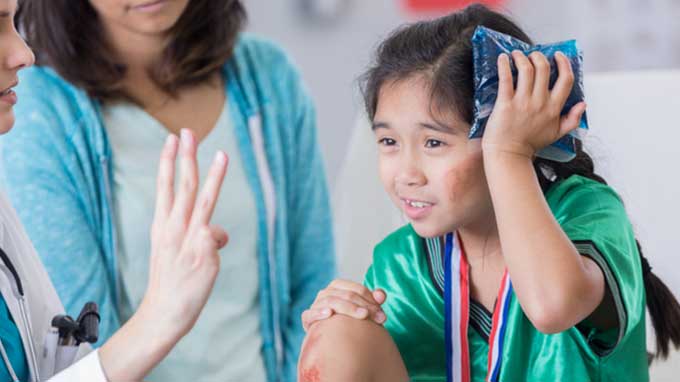Research In Action
Research In Action
Breadcrumb

Concussions are a type of mild traumatic brain injury. Parents often feel overwhelmed and scared when learning their child has one. However, parents can guide their child to a full recovery by proactively engaging with their healthcare provider, school administration, teachers, and coaches at the time of diagnosis and throughout their child’s recovery. As a pediatric sports medicine specialist, I have treated countless concussions. Here is advice to share with parents about what they can expect during their child's recovery.
What Parents Should Do After a Concussion Diagnosis
- Alert the school. Upon receiving a concussion diagnosis, it’s important for parents to contact the school as soon as possible about their child’s absence. This will allow the school to begin making the necessary adjustments to promote the student’s healthy recovery.
- Recognize the symptoms. Every child’s concussion is unique, with a different range of symptoms and also different severities of each symptom. This influences a child’s recovery trajectory, so it’s helpful for parents to stay attuned to their child’s symptoms and to track them over the first few days to weeks. I recommend parents create and share a concussion symptom log with their child’s physician to mark progress with symptoms.
This tracking also helps both the parents and the physician make decisions on what activities are appropriate during each stage in the recovery process. Logging their child’s concussion symptoms can also help alert the parent or the physician of any lingering concussion symptoms, which should be addressed. It’s also important that parents help their child recognize what worsens symptoms so that they can help their child learn to pace him or herself and manage his or her symptoms for whatever stage of recovery he or she is in. - Create a Return to Learn and a Return to Play plan. At the time of diagnosis, parents should talk with their child’s physician about activity modification early after injury to allow symptoms to decrease and about the gradual reintroduction of learning and physical activities. Our “Road to Recovery” infographic can be helpful to parents in understanding what each recovery stage means. The road to recovery can take days or weeks depending on the child’s symptoms, but early relative rest and a gradual return to activities is critical to achieving a healthy recovery.
- When the child is ready to go back to school, the school should be prepared to make adjustments to create a smooth and successful transition. Temporary academic adjustments to take academic pressure off injured students may include adapting the classroom and academic workload to match the child’s recovery. As noted in the “Road to Recovery,” children may need to initially return for a half day of school or take frequent breaks during the day with a reduced workload and then gradually increase time and workload as cognitive stamina improves.
- At this stage, the goals for school are rehabilitative and recovery-oriented, not the usual academically-oriented goals for academic achievement. If the child also participates in sports, it’s important to follow CHOP’s Return to Play plan to further promote recovery and to prevent re-injury. Physical activity can be helpful in promoting recovery, but the child should not participate in activities where he or she is at risk for another concussion.
- Stay alert to mental health and wellness. During the recovery process, the child may feel frustrated and even anxious or depressed by the limitations imposed on learning, social activities, and athletics due to the concussion. In addition, these feelings may be amplified by the concussion itself, so it is critical that parents monitor their child’s mood and support him or her while making their physician aware of any major concerns.
At CHOP, we have found that initial relative rest, followed by a guided gradual return to activity, including academics and athletics, is the best strategy for recovery. We recommend parents follow these steps to successfully guide their child to a full recovery.

